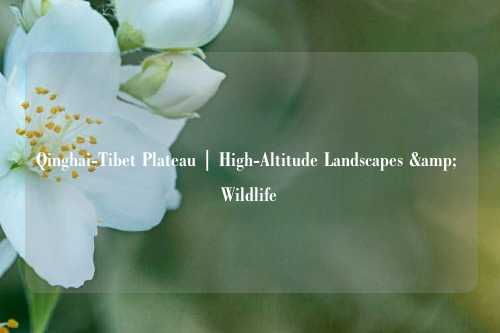Qinghai-Tibet Plateau | High-Altitude Landscapes & Wildlife
The Untamed Beauty of the Qinghai-Tibet Plateau
The Qinghai-Tibet Plateau, often referred to as "Roof of the World," is a land of superlatives. Situated at an average elevation of over 4,500 meters (14,763 feet), it is the highest and largest plateau on Earth. This vast expanse, spanning over 2.5 million square kilometers, is home to some of the most iconic natural landscapes and a array of wildlife. The plateau’s rugged terrain, pristine alpine meadows, and crystal-clear lakes make it a haven for nature enthusiasts and adventurers alike.

One of the plateau’s most striking features is its diverse topography. The Tibetan Plateau is a mosaic of snow-capped mountains, deep valleys, and high-altitude lakes. The towering peaks of the Himalayas, including Mount Everest, form the western boundary of the plateau, while the rolling grasslands of the interior create a sense of endless horizons. The interplay of light and shadow on these mountains and landscapes creates a visual symphony that captivates every visitor.
Among the plateau’s many natural wonders, Qinghai Lake stands out as a gem. Known as the "Blue Sea at the Roof of the World," this saltwater lake is the largest saltwater lake in China and one of the highest-laying large lakes in the world. Its shimmering blue waters are fed by several tributaries, and the surrounding wetlands are a stopover for migratory birds. The serene beauty of Qinghai Lake, especially during sunrise or sunset, is nothing short of magical.
Another must-see is the alpine meadows of the plateau. These green fields, dotted with wildflowers, are a stark contrast to the arid and rocky landscape one might expect at such high altitudes. The meadows are not only visually stunning but also crucial for the survival of the plateau’s wildlife. They provide a source of food and shelter for animals like the Tibetan antelope and wild yak, as well as for migratory birds that traverse the region.
The plateau’s climate is as extreme as its landscapes. The thin air at such high altitudes can make breathing difficult, and the temperature can drop sharply even during the daytime. However, this harsh environment is precisely what makes the Qinghai-Tibet Plateau so . The lack of human interference in many parts of the plateau has allowed its ecosystems to remain largely untouched, creating a sanctuary for some of the planet’s most rare and endangered species.
Wildlife of the Qinghai-Tibet Plateau
The Qinghai-Tibet Plateau is a hotspot for wildlife enthusiasts. Its high-altitude environment and diverse ecosystems support a wide variety of species, many of which are found nowhere else on Earth. From the elusive snow leopard to the graceful Tibetan antelope, the plateau’s wildlife is both resilient and breathtaking.
One of the most iconic animals of the plateau is the Tibetan antelope, also known as the chiru. These gentle creatures are perfectly adapted to the harsh high-altitude environment, with thick, white fur that keeps them warm during the freezing winters. The Tibetan antelope is also known for its horns, which were once a prized commodity in Chinese medicine. However, due to excessive hunting, the Tibetan antelope population has drastically declined over the centuries.幸运的是, through conservation efforts, their numbers have started to recover.
Another apex predator of the plateau is the snow leopard. These powerful cats are a symbol of the high mountains and are often referred to as the "Ghosts of the Roof of the World." Snow leopards are highly elusive, and their striking golden-yellow coats with black rosettes make them a sight to behold. They are skilled hunters, preying on animals like the Tibetan sheep and wild goat. Despite their majesty, snow leopards are facing threats from habitat loss, climate change, and human-wildlife conflict, making their conservation a pressing concern.
The plateau is also home to the Tibetan wild donkey, or kiang. These large, sturdy animals are a familiar sight on the open grasslands, where they graze in herds. Kiangs are known for their vocalizations, which resemble a cross between a donkey’s bray and a horse’s neigh. They play a crucial role in maintaining the health of the grasslands, as their grazing helps to keep the vegetation in check.
In addition to these larger mammals, the plateau is also a haven for birds. The black-necked crane, a rare and highly endangered species, nests on the plateau’s wetlands during the summer months. These elegant birds are a symbol of beauty and grace, and their presence highlights the importance of preserving the plateau’s fragile ecosystems.
The Qinghai-Tibet Plateau is not just a land of landscapes; it is a living, breathing ecosystem that supports an in array of wildlife. However, this delicate balance is under threat from human activities such as deforestation, mining, and urbanization. Conservation efforts are crucial to protect the plateau’s biodiversity and ensure that its natural wonders continue to inspire future generations.
Conclusion: The Qinghai-Tibet Plateau is a land of contrasts, where the highest peaks meet the most remote landscapes, and where resilient wildlife thrives in an environment that defies the odds. Its untamed beauty and ecosystems make it a place of wonder and inspiration. As we continue to explore and appreciate the natural treasures of the plateau, it is our responsibility to protect them for the sake of both the wildlife and the planet as a whole. The journey through the Qinghai-Tibet Plateau is not just a travel experience—it is a reminder of the fragile yet magnificent ecosystems that sustain life on Earth.
















